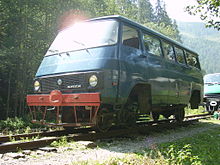- Mocăniţă
-
A mocăniţă (Romanian pronunciation: [mokəˈnitsə]) is a narrow gauge railway in Romania, most notably in Transylvania and nearby regions. Archetypely, they are situated in mountainous areas and the locomotives operating on them (which themselves can also be referred to as mocăniţăs) are steam-powered. These railways were built for cargo and passenger services - some in the era of the Austro-Hungarian Empire, before 1920 - but fell into disrepair over the years. Some are now being rehabilitated for the purposes of tourism.
Contents
Etymology
The word mocăniţă is a term of endearment, derived from the Romanian word mocan, meaning shepherd or one who lives in the mountains, and suffixed as feminine and diminutive in keeping with the tradition of naming conveyances and indicating small size. It's also been suggested that it means "coffee machine", as one of the little locomotives is reminiscent of one of these in action.[1]
Vasar Valley Mocăniţa
The most well-known mocăniţă runs in the Vaser Valley in Maramureş County. This railway was constructed in the period 1933-1935 and uses a gauge of 760 mm (2 ft 5 7⁄8 in). It was partially destroyed by German troops during the war, but was rebuilt again. It has primarily been used for logging, and is still used for this purpose, but in 2004 work began on rehabilitating it as a tourist attraction. A Swiss enthusiast who came to Romania in 1987 helped this greatly by starting an organisation for saving the railway: "Hilfe für die Wassertalbahn in Rumänien". Several steam engines are used: 764-211 (Măriuţa) was built in Berlin by Orenstein & Koppel in 1910; 763-193 (Krauss) was also built in Germany, in 1921; and there are five Romanian locomotives built at Reşiţa between 1953-1955. Diesel engines (built in 1960s-1970s) and other vehicles such as converted minvans also run on the lines. The latter are used by border police, rangers and others for getting quickly up the mountains.
The tracks run from Vişeu de Sus, from a yard on Strada A. I. Cuza, 1.5 km north from the town centre. The main line is 43 km long, from Vişeu de Sus to Comanu, near the Ukrainian (former Polish) border, though the service may terminate before then at Faina. This trip usually takes between 3 and 4 hours each way. There are two other branches: along the Novat Valley (13 km) and towards Stevioara (3 km). The train can occasionally come off the rails, but at a speed of 10 km/hour this poses no danger, and experienced passengers help to get the train back on the rails! The Vaser Valley is an exceptionally scenic location, the habitat of many bears and deer, along with many cattle and sheep. The line is run by a private company, Căile Ferate Forestiere (CFF). As well as regular services, trains can be charted by tourists; special services are also run, for instance on New Year's Eve. This video made about this Mocăniţă is accompanied by local music from Maramureş.
The railway, and the Mariuța engine complete with rolling stock featured in episode 3 "Wild East" ("From the Dniestr to the Danube" in the US version) of Michael Palin's New Europe. It can be viewed in part 3 of that episode on YouTube at time index 2 minutes 54 seconds.
Other mocăniţas
- In the Aries mountains region of Alba county (in Romanian only). Trains are now operating on Abrud to Câmpeni section of this line; it is planned that in the future they will run from Abrud to Turda. When operated as a non-tourist railway the journey time for the 93 kilometre trip from Turda to Abrud took some six and a half hours. (CFR timetable 1988).
- In the Hartibaciu valley from Sibiu to Agnita This line is now designated as a historical monument, so it is saved from being scrapped and the plans to revive it may now go ahead.
- From Covasna (Kovászna) to Comandău in Covasna County Regular journeys last occurred here in 1999, but an association was formed in 2002 to save the train and a number of trips have since been made. A video of this mocăniţa (in German)
- From Crişcior to Brad in Hunedoara county (in Romanian only). The line is currently classed as a historical heritage line and used for tourism on holidays. An amateur video of a mocăniţa at Brad
- Other lines have been suggested as candidates for conversion into "mocăniţă" tourist attractions, and some activity has been attempted on some of these though the situation may not be stable. These include the following lines: Târgu Mureş (Marosvásárhely) to Band (Mezőbánd), Dorneşti to Nisipitu, and at Moldoviţa - though some of these may run on standard-gauge track.
External links
-
Vasar Valley
- A website by the company running the Vasar Valley mocăniţă, including up-to-date news
- A website focusing on CFF's Orenstein&Koppel 764-211 locomotive
- Official Vasar Valley tourism website
- A multilingual Vasar Valley tourism website, set up by a mocăniţă ticket collector
- Blog entry quoting technical details (by Adela Ulici and Teofil Ivanciuc) about Vasar Valley mocăniţă - quoted in this article
- Ecotours: A company offering tourist opportunities in Viseu de Sus
- Hilfe für die Wassertalbahn in Rumänien ("Help for the Vasar Valley Railway")
- Information and video with the steam train from Maramures
Other
- The Association for Narrow Gauge Railways Maintenance
- List of Narrow Gauge Steam Locomotives in Romania - in 2001
- A survey of mocăniţă activity in 1998
- Sibiu to Agnita line in the Hartibaciu valley
References
- ^ "The Restoration of the Sibiu to Agnita Narrow-Gauge Railway". transylvaniaexpress.com. http://www.transylvaniaexpress.com/agnita/restoration.html. Retrieved 2007-11-18.
Categories:- Rail transport in Romania
- Visitor attractions in Romania
- Forest railways
Wikimedia Foundation. 2010.



